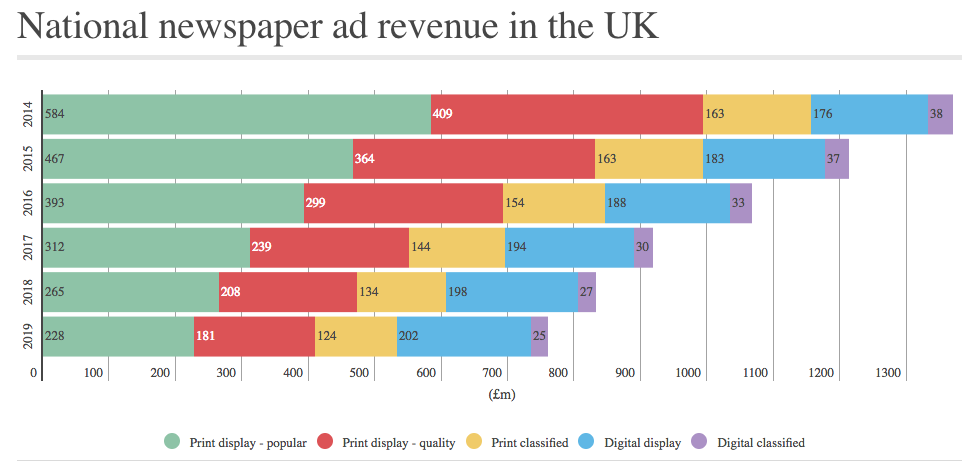![]()
#Publishing
When I heard that Backchannel would be moving to Wired while Google’s Contributor service (“buy an ad removal pass for the web”) was not only rolling out, but already deployed by some publishers (e.g. by Business Insider UK)—and while Wired (with the rest of Condé Nast) was still mistaking tracking protection for ad blocking (and hitting readers with the same lame interruptive shakedown popover I wrote about over a year ago)— I copied and pasted this section of the Daily Tab into Medium and expanded it into a piece titled How To Plug the Publishing Revenue Drain. I also wanted to get it up in advance of the Gillmor Gang webcast/podcast I’d be on that afternoon.
The (not so great) state of UK print advertising in 4 charts (Lucinda Southern @Lucy28Southern in DigiDay) Here they are:

Publishers can reverse that. Here’s how:
- Follow their customers’ lead. That means they should—
- Fire adtech (tracking-based advertising), which is full of fraud and malware, clogs data pipes, spies on people (which will soon be illegal in the EU thanks to the GDPR), and carries enormous operational and cognitive overhead for everybody. This will—
- Save journalism from drowning in a sea of content. (The problem with content is that it’s not editorial. It’s eyeball bait.) To do this publishers should—
- Agree to readers’ terms and conditions. These will live at Customer Commons (much as individuals’ copyright terms live at Creative Commons) and can be expressed in one line of code in the reader’s browser. The first and simplest term is called #NoStalking and says “just give me ads not based on tracking me.” These ads—simple brand ads—are far more valuable, and brand-supporting, than anything adtech has ever done, or ever can do. They also sponsor the publisher, which adtech also can’t do, because its actual business is chasing eyeballs. With #NoStalking, publishers will—
- Get cleaner, better and more supportive sponsorship from advertisers than they ever got from adtech. Agreeing not to stalk readers will also pave a way off the cattle ranches of Facebook and Google while also getting out of adtech’s bubble before it bursts. It will also respect The Castle Doctrine—for everybody involved, including readers, publishers, advertisers and intermediaries.
Bonus link: After Peak Marketing. And everything by Bob Hoffman (@adcontrarian), Don Marti (@dmarti), Augustine Fou, aka Ad Fraud Researcher (@acfou), WhiteOps (@WhiteOps), Dave Carroll (@profcarroll) and @MikkoKotila.
#Advertising vs. #Adtech
As Apple and Google take aim at ads, publishers tremble (Lucia Moses @lmoses in DigiDay)
De-blurring Lines Between ‘Ad Tech’ and Advertising (Daniel Meehan @MeehanDaniel in Martech Series). I’m kindly sourced: “…Doc Searls dug into what on earth brands are doing — and have been doing for years. He’s just as confused by this shift of advertisers effectively offloading their jobs to algorithms. Searls also calls for an end to ad tech, in favor of a return to “traditional” advertising approaches. The state of ad tech’s been killing media, too. And he wants to save it before we venture too far.”
Also by Daniel, this time in Martech Today: Stop Calling ‘Ad Tech’ Advertising. Bonus link: Separating Advertising’s Wheat and Chaff.
Not listening to either Daniel or me:
- Acxiom Adds Targeting for Marketers On LinkedIn (Tobi Elkin @tobielkin in MediaPost). Related: Acxiom’s LiveRamp Connect and LiveRamp IdentityLink. Sugar-coated surveillance sold as more personalized aiming of marketing messages.
- Mary Meeker, in all the below…
#Random
Saturn is amazing. (Time)
Introducing FilterBubbler: A WebExtension built using React/Redux. Based on this idea by @dmarti. (Ean Schuessler in Mozilla Hacks) “The idea was to turn the tables on the kinds of sophisticated analysis that advertisers do with the everyday browsing activities we take for granted.”
Leave a Reply